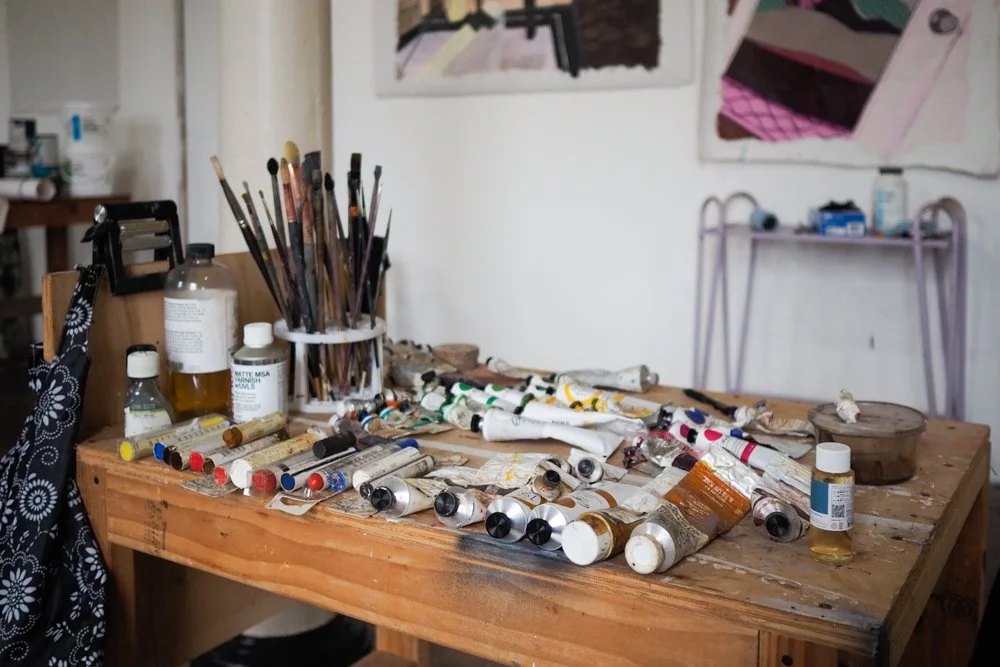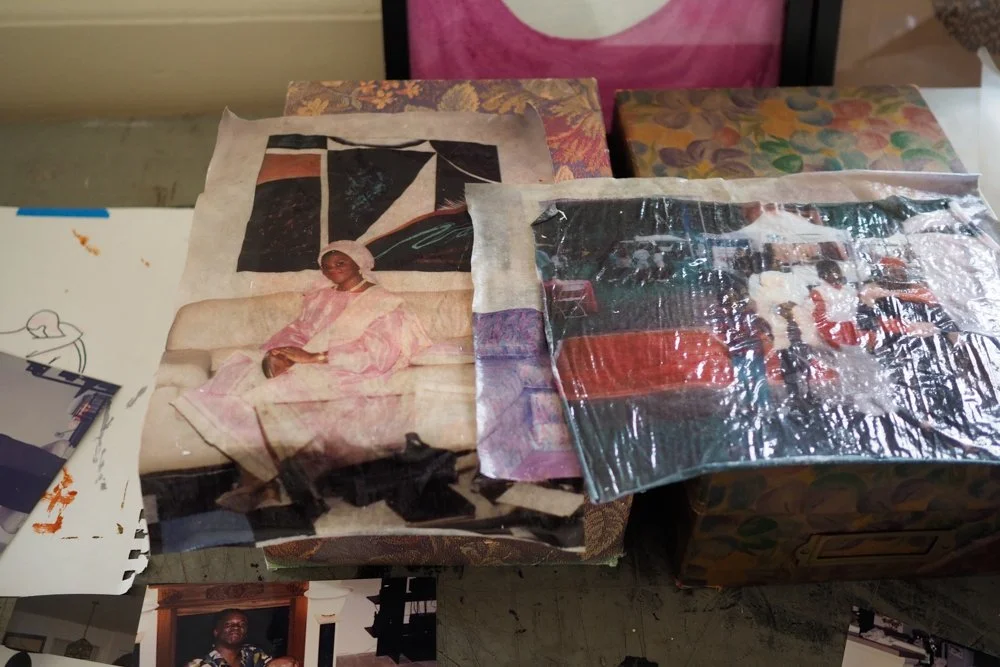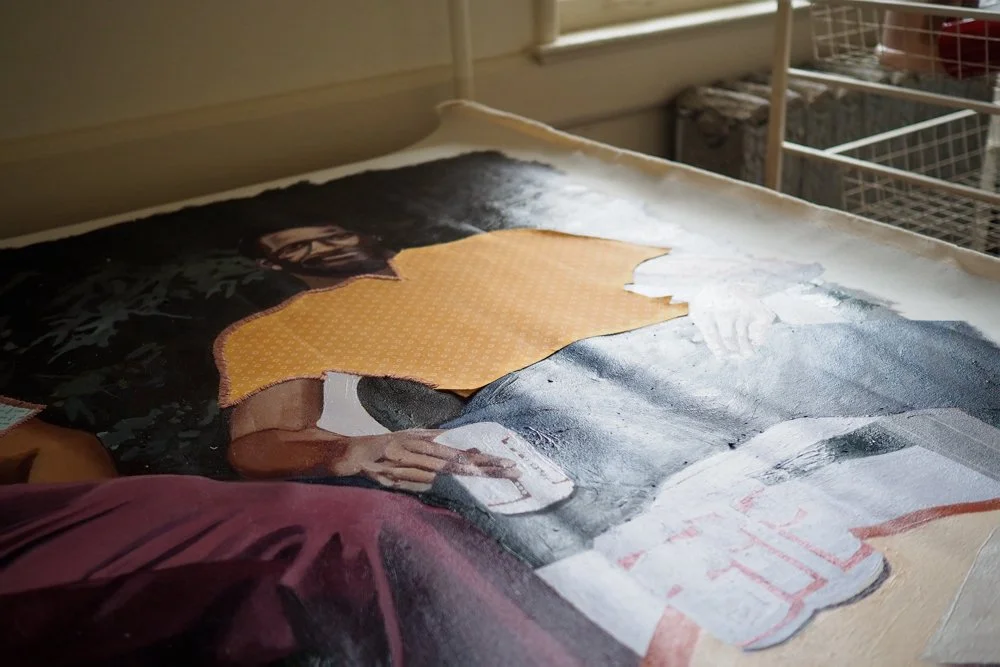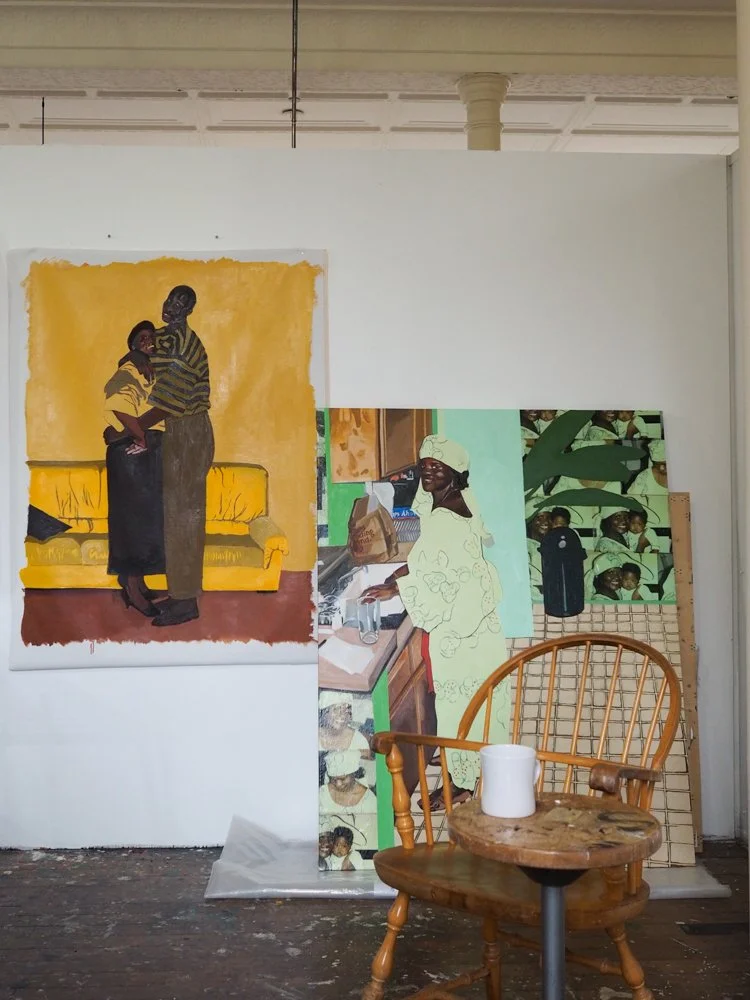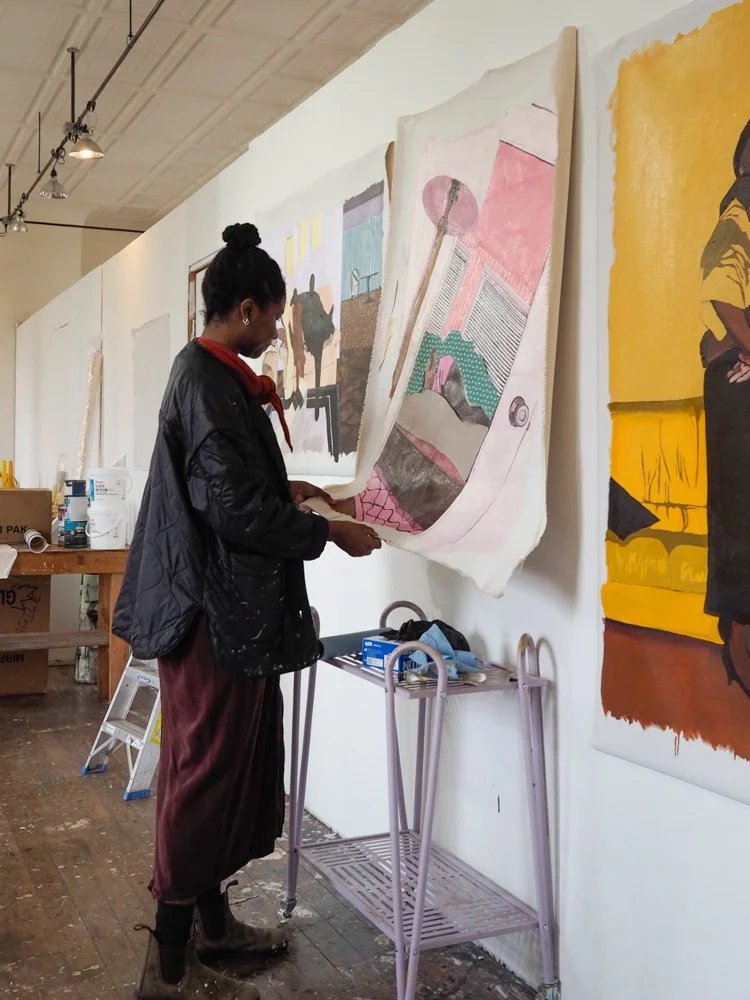WITH NIMAH GOBIR
NIMAH GOBIR
“Empathetic interiors is such a beautiful idea....It’s tied to the idea of showing specificity—painting the clutter, the odd objects, the unique formats of a home.”
Across Nimah Gobir’s vibrant canvases and sculptural installations lies a deeply personal archive—an inheritance of family photographs, textiles, and lived memories. Her work begins with the quiet act of looking: sorting through snapshots of Nigerian-born parents and extended family dispersed across Nigeria, London, and the U.S. These images become the raw material for layered domestic portraits that weave together memory, migration, and identity. By integrating photo transfers, expressive brushwork, and hand-stitched embroidery, Nimah blurs the boundary between documentation and devotion, creating pieces that resonate with both specificity and emotional depth.
Her approach to materials is both intuitive and intentional. Found fabrics and quilted patterns evoke the textures of home—familiar yet deeply personal. Hand stitching functions as both craft and metaphor, a symbolic gesture of care that connects past and present. Whether threading textiles into the clothing of painted figures or layering photo fragments within a composition, Nimah builds a visual language grounded in tenderness, repetition, and touch. The result is work that honors the beauty of domestic life and the nuanced ways in which identity is shaped by space, memory, and kinship.
Recent explorations into sculptural forms have further expanded Nimah’s practice. Salvaged materials, painted vacuums, and wrapped industrial spools become extensions of the same themes—offering tactile entry points into stories of inheritance and belonging. Whether capturing the intimacy of hair-braiding rituals or the quiet elegance of a worn living room couch, Nimah’s pieces speak to the resilience of diasporic life. They are not simply portraits or objects, but vessels of connection—each one a stitched-together memory, alive with the emotional weight of home.
We visited Nimah at her studio at the Headlands Center for the Arts where she recently completed a residency.
CL: What early experiences shaped your sense of self as a creative person?
NG: The earliest memory I have of experiencing art was my dad making one of those two-page animations—where you draw a picture on one page, then a slightly different one on the next, and you move the paper back and forth so it looks like it’s moving. I remember thinking it was the most amazing thing I’d ever seen. It created a link in my mind where I thought, art-making is basically magic. You’re a magician.
That, combined with always having access to art classes—I went to public school my entire life and was lucky there were art classes every year—I kept that going.
I also recognized that there’s a gap in the body of work that gets highlighted. Black people often appear in marginal roles, or the breadth of work that exists isn’t given the same visibility. I want to contribute to that body of work. That’s part of why many of my paintings show mundane moments. There needs to be more mundane intimacy in the canon of artwork, and I think Black people need to be at the center of it. We experience joy, resistance, and these small, intimate moments that express our humanness.
CL: What do you hope people feel or understand when they experience your work?
NG: I hope it feels familiar. I want people to feel like they’re entering a house—maybe not their house, but a domestic space that’s recognizable. There’s a lot of color and softness in my work, and I’d love for people to feel welcome. I want them to want to get closer, whether to see objects or textures. I’m hoping to create a kind of coziness.
CL: I get that feeling when I look at your work—like I want to be there. It feels comfortable and joyful, like a warm embrace.
NG: That makes me happy. And with the photo transfers I’ve been introducing, I also want it to feel like walking into a photo album, if a photo album had its own space.
CL: How has your work changed as your sense of self has changed? What has that evolution been?
NG: It has changed, and I’ve changed too. I’ve become more comfortable with experimentation. Entering the art world—showing in galleries, building a collector base—can pressure you into creating a certain kind of work. But as I’ve continued and spent more time in the Bay Area, I’ve shifted toward a mindset of abundance. I feel I owe it to myself to explore what I’m obsessed with or interested in. The audience will come—or not—and that’s okay.
I used to think I needed to find the next best thing or do a lot of different things. But now I’m comfortable staying with what has my interest. I owe it to myself to follow that, regardless of perception. I feel okay being deep with something and also okay moving on.
I’m less focused on the audience or the next show and more on the process. I’m in it for the process—sitting with photos, talking to relatives, exploring new techniques. That’s where the value is for me.
CL: It’s about staying true to what you want to do, which is always a struggle when there’s external pressure.
NG: Definitely. I’ve been fortunate to work with institutions, but that can come with pressure. As I’ve gotten older, I’ve learned to step back and set boundaries. That pressure will always exist, but I’m allowed to say no to a show if I’m working through new ideas, or to make something three-dimensional even if that’s not what collectors expect. It’s about creating space for myself. That’s become easier over time, though it once felt hard.
CL: What’s something you’ve let go of creatively, and what’s taken its place?
NG: That’s a great reflective question, especially during a time of transition. I’ve applied to a lot of residencies and awards—some I get, some I don’t. Earlier on, not getting them felt like a blow to my confidence. Now I understand the group always changes, the jurors change, the process changes. It feels a lot less devastating.
That may not be a strictly creative change, but it’s a shift. These things often come back around—you might get nominated again. I’ve learned not to change in response to those outcomes. They change on their own.
So I keep those things on the periphery. They’re part of the art ecosystem, part of sustaining the practice, but they don’t define the practice itself.
CL: As a designer, my goal is to unify objects and context—the form and the field. I’m curious how context influences your work.
NG: I’ve been thinking more about that with an upcoming museum show. I had a great visit from someone at the ICA in Atlanta who helped me understand the difference between museum and gallery spaces.
Gallery spaces usually have white walls, and the purpose is often to sell the work. Museums, by contrast, are more of a community space. You’re not necessarily trying to sell work; you’re creating an atmosphere for it. That shift has been important for me to understand, since galleries were my first experience.
Now I’m thinking more about creating immersive experiences—what color the walls are, how the lighting feels, whether it’s bright or soft. I’ve shown work in smaller, enclosed spaces that feel intimate, and I’m exploring how to increase that sense of closeness and being enveloped. That’s been an implicit element, but I’m becoming more intentional about it.
CL: Is there a specific future exhibition you’re thinking about in that context?
NG: Yes, the ICA show for sure. I’ve thought about it in other shows too—at MoAD we painted the walls, and when I proposed for the SFMOMA SECA Award, I was thinking about what the space would feel like.
There’s so much you can do. I saw Mickalene Thomas’s show at the Broad—she recreated a house façade and a living room, and it felt like stepping into her mom’s space. It really placed you in the artist’s mindset. That kind of immersive storytelling is powerful.
CL: Last question: my work focuses on empathetic interiors, drawing from people’s history, values, and identity as inspiration for their future. What does empathy mean to you? Do you see it in your work?
NG: I love that—empathetic interiors is such a beautiful idea. There’s a trend toward cold, detached interiors, but empathy feels more personal to me. It’s tied to the idea of showing specificity—painting the clutter, the odd objects, the unique formats of a home.
Not editing those things out gives viewers a chance to really know that moment, that household. It’s the difference between tidying up for strangers versus letting old friends see the dishes in the sink. I hope my work offers that kind of honesty—an opportunity for empathy, a chance to really know my family and the Black experience. By showing perhaps a little too much, I hope to communicate something more universally human.
Nimah is represented by Johansson Projects.


